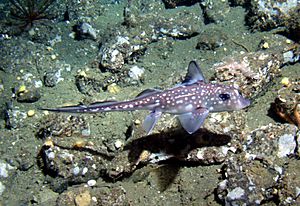Holocephali facts for kids
Quick facts for kids HolocephaliTemporal range: 416–present Devonian–present
|
|
|---|---|
 |
|
| Hydrolagus colliei, a rat fish | |
| Scientific classification |
|
| Kingdom: | Animalia |
| Phylum: | Chordata |
| Class: | Chondrichthyes |
| Subclass: | Holocephali |
| Orders | |
|
|
Holocephali are a special group of fish. Their name means "complete heads." These fish are part of the cartilaginous fish family, which means their skeletons are made of tough, flexible cartilage instead of bone. The only living members of this group today are the chimaeras, also known as ratfish or ghost sharks.
Meet the Holocephali
Holocephali are fascinating creatures that have been around for a very long time. Unlike most fish you might know, they don't have bony skeletons. Instead, their bodies are supported by cartilage. This makes them related to sharks and rays.
The most well-known Holocephali today are the chimaeras. These deep-sea fish have unique looks. They often have large eyes, long, whip-like tails, and smooth skin. They use their strong jaws to crush the shells of creatures they eat.
Ancient History of Holocephali
Holocephali have a very long history on Earth. Scientists have found fossils of these fish that date back to the Devonian period. This was about 416 million years ago!
Most of the fossils found are just teeth. This is because cartilage doesn't preserve as well as bone. So, it's often hard for scientists to know exactly what these ancient fish looked like. Even with mostly teeth, we know they were diverse.
Scientists have studied the genes of living chimaeras. This research suggests that the entire Holocephali group first appeared even earlier. They likely originated around 420 million years ago, during the Silurian period. This makes them truly ancient survivors of the ocean.
See also
In Spanish: Holocéfalos para niños

